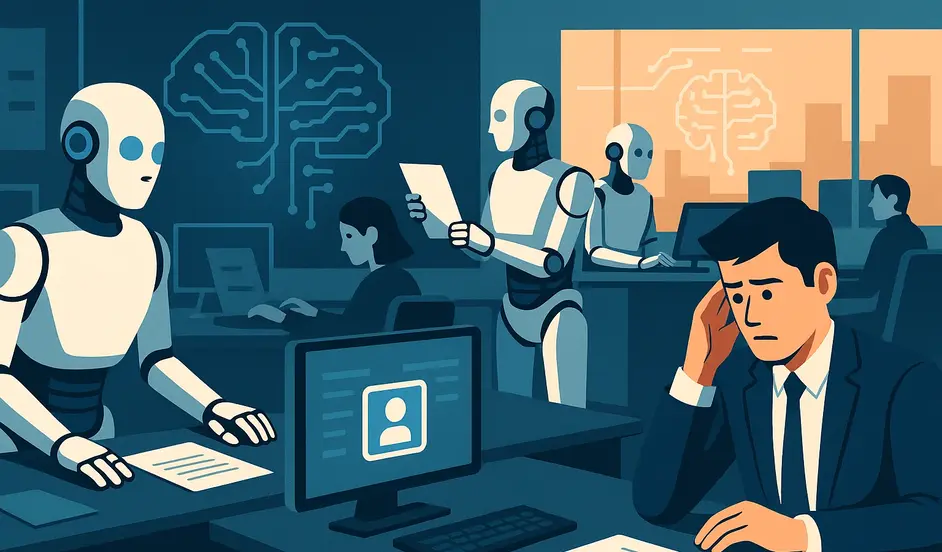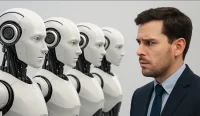AI Job Disruption 2025 marks one of the biggest changes in the modern workforce. According to new projections from the World Economic Forum (WEF) and major consultancies, artificial intelligence could eliminate nearly half of all entry-level white-collar jobs within the next decade. This wave of automation may push U.S. unemployment to levels not seen in generations.
While the technology industry has already felt the sting of layoffs, analysts warn that the ripple effect is about to spread far beyond Silicon Valley, reshaping finance, marketing, law, and customer service. Even CEOs of leading AI companies have sounded the alarm, warning that the pace of automation could bring about a “bloodbath” in jobs once considered secure stepping stones for graduates.
Table of Contents
The Scale of the Disruption
The WEF study estimates that nearly a quarter of all current professions will be altered by AI within five years, while 83 million jobs globally could be eliminated by 2027 due to automation. Goldman Sachs projects that up to 300 million full-time roles could be disrupted worldwide.
In the U.S., where white collar office work represents a significant share of employment, as many as 10–12 million entry-level positions may vanish within the decade. That equates to nearly 46% of the tasks performed by junior employees, most of which involve routine information processing, research, or administrative support.
The tech industry’s struggles provide a preview of what’s coming. Major companies like IBM, Accenture, and Deloitte have paused junior hiring programs, cut tens of thousands of roles, and openly admitted that many tasks traditionally performed by new recruits are now better handled by AI. IBM alone stated it would stop hiring for 26,000 administrative positions—from human resources to finance—because AI can perform the same functions faster and cheaper.
Customer Support: The Frontline of AI Adoption
Customer service is at the epicenter of AI’s workforce impact. AI-powered chatbots already manage 85% of first-level support requests in large tech firms, compared to just 30% in 2020. These tools are not only replacing human labor but also driving efficiency gains for companies.
For example, McKinsey reports that generative AI could automate 60–70% of working time in certain office occupations. This has led firms to re-evaluate the need for entry-level call center workers, many of whom once relied on these jobs as a gateway to corporate careers.
The legal sector is also transforming rapidly. Tools like CaseText and DoNotPay are drafting contracts, conducting research, and even helping consumers contest traffic tickets or eviction notices. DoNotPay claims to have handled 1.5 million cases, saving clients millions in legal fees—work that might once have required junior paralegals or attorneys.
Entry-Level Collapse: Internships and Training Programs at Risk
The disappearance of junior roles is eroding the professional pipeline itself. Traditionally, internships and entry-level jobs served as the critical bridge between education and full-time employment. But that bridge is collapsing.
The National Association of Colleges and Employers reported a 22% drop in internship offers from Fortune 500 companies between 2022 and 2024, with tech internships down by 34%. Without these pathways, graduates struggle to gain the experience needed for mid-level positions, creating bottlenecks that could cripple workforce development for decades.
This is not just a corporate issue—it’s a macroeconomic one. Entry-level jobs provide on-the-job training, skill acquisition, and upward mobility. Without them, industries may face a shortage of qualified talent at the mid- and senior levels within 10 years.
Support the Next Generation of Talent
Post your job on WhatJobs and create opportunities for interns, graduates, and entry-level candidates—helping to close the gap as training programs decline.
Post a Job Now →Wage Stagnation and Polarization
AI is not only eliminating jobs but also holding down wages for those who remain. The Federal Reserve Bank of San Francisco reported that real wage growth for entry-level professional jobs fell 1.8% in 2024, even as the overall economy saw a 2.4% increase.
At the same time, the labor market is polarizing:
- High-demand roles: AI engineers, data scientists, and senior executives.
- Low-wage service jobs: Retail, food service, caregiving, and hospitality—roles that require physical presence or human empathy.
- Disappearing middle: Junior white collar positions once filled by recent college graduates.
This imbalance threatens to widen inequality, creating a workforce bifurcated between high-paid tech specialists and low-wage service workers.
Case Study: IBM and Accenture Lead the Shift
When IBM announced cuts of nearly 3,900 jobs in early 2025, the company was blunt: many of the eliminated positions were roles AI could now handle. Human resources, payroll, and administrative tasks—once considered secure corporate jobs—were deemed redundant.
Similarly, Accenture’s 2024 report revealed the company would cut 19,000 staff, primarily among non-billable and junior-level employees, even as it increased investments in AI consulting. The message to workers was clear: the future belongs to technology, not trainees.
Economic Risks: Student Loans and Spending Power
The collapse of entry-level opportunities has far-reaching consequences. A Congressional Budget Office (CBO) projection warns that student loan delinquency could climb from 7.8% to 12.5% by 2027 as graduates face shrinking job prospects.
Unemployment among workers aged 22–27 with at least a bachelor’s degree is already higher than the national average, fueling concerns that consumer spending will decline. If younger workers cannot find stable jobs, their ability to pay rent, repay loans, or participate in the economy will diminish—threatening long-term growth.
Why This AI Wave Is Different
Past waves of automation, such as spreadsheets or factory robotics, tended to support human productivity rather than replace it. Generative AI is different: it can complete entire tasks from start to finish without human intervention.
A 2024 MIT study found AI adoption caused a 19% decline in job postings for repetitive cognitive tasks, while openings for AI engineers and product managers rose by 11%. In practice, this means that for every AI-related role created, two to three junior positions vanish.
What Comes Next?
Experts warn that unless new pathways for skill development are created, the U.S. risks a collapse of upward mobility. Without entry-level positions, tomorrow’s workforce will lack the training and experience needed to replace retiring senior professionals.
While AI will undoubtedly create new categories of work—such as AI governance, model training, and ethics—these roles require specialized expertise that recent graduates often lack. The danger is that a generation of young workers could be left behind.
FAQs
1. Which jobs are most at risk from AI in the next five years?
The most vulnerable are entry-level administrative and routine cognitive roles: customer service, HR support, junior legal researchers, data analysts, and marketing assistants. These jobs involve repetitive tasks that AI can automate efficiently.
2. Will AI create new jobs to replace the ones it eliminates?
Yes, but not at the same scale. AI-related fields like engineering, model training, and governance are growing, but for every AI job created, two to three traditional entry-level jobs disappear. The mismatch between skills required and the labor pool available creates challenges.
3. How will this affect new graduates entering the workforce?
Graduates face fewer entry-level job opportunities, more competition, and stagnant wages. Internships and training programs are also shrinking, making it harder for young professionals to gain the experience needed for career advancement.
4. What can workers do to prepare for the AI-driven job market?
Workers should focus on skills AI struggles to replicate, such as critical thinking, creativity, interpersonal communication, and leadership. Upskilling in AI-related fields like prompt engineering, data science, or product management can also improve employability.




